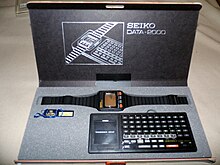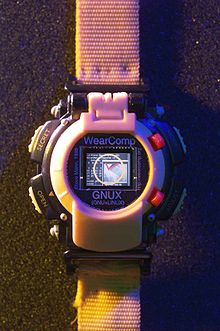Future Watch Technology
A smartwatch is a wearable computer in the form of a watch; modern smartwatches provide a local touchscreen interface for daily use, while an associated smartphone app provides for management and telemetry (such as long-term biomonitoring). While early models could perform basic tasks, such as calculations, digital time telling, translations, and game-playing, 2010s smartwatches have more general functionality closer to smartphones, including mobile apps, a mobile operating system and WiFi/Bluetooth connectivity. Some smartwatches function as portable media players, with FM radio and playback of digital audio and video files via a Bluetooth headset. Some models, called 'watch phones' (or vice versa), have mobile cellular functionality like making calls.[1][2][3]
While internal hardware varies, most have an electronic visual display, either backlit LCD or OLED.[4] Some use transflective or electronic paper, to consume less power. They are generally powered by a rechargeable lithium-ion battery. Peripheral devices may include digital cameras, thermometers, accelerometers, pedometers, heart rate monitors, altimeters, barometers, compasses, GPS receivers, tiny speakers, and microSD cards, which are recognized as storage devices by many other kinds of computers.
Software may include digital maps, schedulers and personal organizers, calculators, and various kinds of watch faces. The watch may communicate with external devices such as sensors, wireless headsets, or a heads-up display. Like other computers, a smartwatch may collect information from internal or external sensors and it may control, or retrieve data from, other instruments or computers. It may support wireless technologies such as Bluetooth, Wi-Fi, and GPS. For many purposes, a "watch computer" serves as a front end for a remote system such as a smartphone, communicating with the smartphone using various wireless technologies. Smartwatches are advancing, especially their design, battery capacity, and health-related applications.[5] Health-related applications include applications measuring heart rate, SpO2, workout etc.
History[edit]
Early years[edit]
The first digital watch, which debuted in 1972, was the Pulsar manufactured by Hamilton Watch Company. "Pulsar" became a brand name which would later be acquired by Seiko in 1978. In 1982, a Pulsar watch (NL C01) was released which could store 24 digits, making it most likely the first watch with user-programmable memory, or "memorybank" watch.[6]
With the introduction of personal computers in the 1980s, Seiko began to develop computers in the form of watches. The Data 2000 watch (1983) came with an external keyboard for data-entry. Data was synced from the keyboard to the watch via electro-magnetic coupling (wireless docking). The name comes from its ability to store 2000 characters.[7] Its memory was tiny, at only 112 digits.[6] It was released in 1984, in gold, silver and black.[8] These models were followed by many others by Seiko during the 1980s, most notably the "RC Series". The RC-1000 Wrist Terminal was the first Seiko model to interface with a computer, and was released in 1984.[7] It was developed by Seiko Epson and was powered by a computer on a chip and was compatible with most of the popular PCs of that time, including Apple II, II+ and IIe, the Commodore 64, IBM PC, NEC 8201, Tandy Color Computer, Model 1000, 1200, 2000 and TRS-80 Model I, III, 4 and 4p. The RC-20 Wrist Computer was released in 1985, under the joint brand name "Seiko Epson".[9][10] This was followed by the RC-4000 and RC-4500.
During the 1980s, Casio began to market a successful line of "computer watches", in addition to its calculator watches. Most notable was the Casio data bank series. Novelty "game watches", such as the Nelsonic game watches, were also produced by Casio and other companies.[citation needed]
1990s[edit]
The Timex Datalink wristwatch, was introduced in 1994. The early Timex Datalink Smartwatches realized a wireless data transfer mode to communicate with a PC. Appointments and contacts created with Microsoft Schedule+, the predecessor of MS Outlook, could be easily transmitted to the watch via a screen blinking light protocol.
In 1998, Steve Mann invented, designed, and built the world's first Linux wristwatch,[11] which he presented at IEEE ISSCC2000 on 7 February 2000, where he was named "the father of wearable computing".[12] See also Linux Journal,[13] where Mann's Linux wristwatch appeared on the cover and was the feature article of LJ Issue 75. Seiko launched the Ruputer in Japan - a wristwatch computer with a 3.6 MHz processor. It was not very successful, since instead of a touchscreen it used a joystick-like device to input characters (much like high scores in arcade games), and the small screen with a resolution at 102x64 in 4 greyscales made it hard to read large amounts of text. Outside of Japan, this watch was distributed as the Matsucom onHand PC. Despite the rather low demand, the Matsucom onHand PC was distributed until 2006, making it a smartwatch with a rather long life cycle. Ruputer and onHand PC applications are fully compatible. This watch is sometimes considered the first smartwatch since it was the first watch to offer graphics display (albeit monochrome) and many 3rd party applications (mostly homebrew).
In 1999, Samsung launched the world's first watch phone, the SPH-WP10. It had a protruding antenna, a monochrome LCD screen, and a 90-minutes of talk time with an integrated speaker and microphone.[14]
2000s[edit]
In June 2000, IBM displayed a prototype for a wristwatch that ran Linux. The original version had only 6 hours of battery life, which was later extended to 12.[16] It featured 8 MB of memory and ran Linux 2.2.[17] The device was later upgraded with an accelerometer, vibrating mechanism, and fingerprint sensor. IBM began to collaborate with Citizen Watch Co. to create the "WatchPad". The WatchPad 1.5 features a 320 × 240 QVGA monochrome touch sensitive display and runs Linux 2.4.[18][19] It also features calendar software, Bluetooth, 8 MB of RAM and 16 MB of flash memory.[20][21] Citizen was hoping to market the watch to students and businessmen, with a retail price of around $399.[21] Epson Seiko introduced their Chrono-bit wristwatch in September 2000. The Chrono-bit watches feature a rotating bezel for data input, synchronize PIM data via a serial cable, and can load custom watch faces.[22]
In 2003, Fossil released the Wrist PDA, a watch which ran the Palm OS and contained 8 MB of RAM and 4 MB of flash memory.[23][24] It contained a built in stylus to help use the tiny monochrome display, which had a resolution of 160×160 pixels. Although many reviewers declared the watch revolutionary, it was criticized for its weight (108 grams) and was discontinued in 2005.[25]
In the same year, Microsoft announced the SPOT smartwatch and it began hitting stores in early 2004.[26] SPOT stands for Smart Personal Objects Technology, an initiative by Microsoft to personalize household electronics and other everyday gadgets. For instance, the company demonstrated coffee makers, weather stations, and alarm clocks featuring built-in SPOT technology.[27] The device was a standalone smartwatch[28] that offered information at a glance where other devices would have required more immersion and interaction. The information included weather, news, stock prices, and sports scores and was transmitted through FM waves.[26] It was accessible through a yearly subscription that cost from $39 to $59.[27]
The Microsoft SPOT Watch had a monochrome 90×126 pixel screen.[29] Fossil, Suunto, and Tissot also sold smartwatches running the SPOT technology. For instance, Fossil's Abacus, which was a variant of the Fossil Wrist PDA, retailed from $130 to $150.[30][27]
Sony Ericsson teamed up with Fossils, and released the first watch, MBW-100, that connected to Bluetooth. This watch notified the user when receiving calls and text messages. Though the watch was not popular as it would only connect and work with Sony Ericsson phones.[31]
In 2009, Hermen van den Burg, CEO of Smartwatch and Burg Wearables, launched Burg the first standalone smartphone watch with its own sim card and not requiring to be tethered to a smartphone. Burg received the award for the Most Innovative Product at the Canton Fair in April 2009[32][33][34][35][36][37][38] Also, Samsung launched the S9110 Watch Phone which featured a 1.76-inch (45 mm) color LCD display and was 11.98 millimetres (0.472 in) thin.[14]
2010s[edit]
Sony Ericsson launches the Sony Ericsson LiveView, a wearable watch device which is basically an external Bluetooth display for an Android Smartphone.
Vyzin Electronics Private Limited launched a ZigBee enabled smart watch[39] with cellular connectivity for remote health monitoring called VESAG.[40][41]
Motorola released MOTOACTV on 6 November 2011.[42]
Pebble (watch) was an innovative smartwatch that raised the most money at the time on Kickstarter reaching $10.3 Million between 12 April – 18 May 2012. The watch has a 32-millimetre (1.26 in) 144 × 168 pixel black and white memory LCD using an ultra low-power "transflective LCD" manufactured by Sharp with a backlight, a vibrating motor, a magnetometer, ambient light sensors, and a three-axis accelerometer.[43][44][45][46][47] It can communicate with an Android or iOS device using both Bluetooth 2.1 and Bluetooth 4.0 (Bluetooth Low Energy) using Stonestreet One's Bluetopia+MFi software stack.[48] Bluetooth 4.0 with low energy (LE) support was not initially enabled, but a firmware update in November 2013 enabled it.[49] The watch is charged using a modified USB-cable that attaches magnetically to the watch to maintain water resistance capability.[45] The battery was reported in April 2012 to last seven days.[50] Based on feedback from Kickstarter backers, the developers added water-resistance to the list of features.[51] The Pebble has a waterproof rating of 5 atm, which means it can be submerged down to 40 metres (130 ft) and has been tested in both fresh and salt water, allowing one to shower, dive or swim while wearing the watch.[52]
In 2013, the claim to first ever smartwatch to capture the full capability of a smartphone was laid by startup Omate with the TrueSmart. The TrueSmart originated from a Kickstarter campaign which raised over 1 million dollars, making it the 5th most successful Kickstarter to date. The TrueSmart made its public debut in early 2014.[53] Consumer device analyst Avi Greengart, from research firm Current Analysis, suggested that 2013 may be the "year of the smartwatch", as "the components have gotten small enough and cheap enough" and many consumers own smartphones that are compatible with a wearable device. Wearable technology, such as Google Glass, was speculated to evolve into a business worth US$6 billion annually, and a July 2013 media report revealed that the majority of major consumer electronics manufacturers were undertaking work on a smartwatch device at the time of publication. The retail price of a smartwatch could be over US$300, plus data charges, while the minimum cost of smartphone-linked devices may be US$100.[54][55]
As of July 2013, the list of companies that were engaged in smartwatch development activities consists of Acer, Apple, BlackBerry, Foxconn/Hon Hai, Google, LG, Microsoft, Qualcomm, Samsung, Sony, VESAG and Toshiba. Some notable omissions from this list include HP, HTC, Lenovo, and Nokia.[55] Science and technology journalist Christopher Mims identified the following points in relation to the future of smartwatches:
- The physical size of smartwatches is likely to be large.[56]
- Insufficient battery life is an ongoing problem for smartwatch developers, as the battery life of devices at the time of publication was three to four days and this is likely to be reduced if further functions are added.
- New display technologies will be invented as a result of smartwatch research.
- The success level of smartwatches is unpredictable, as they may follow a similar trajectory to netbooks, or they may fulfill aims akin to those of Google Glass, another wearable electronic product.[57]
Future Watch Technology
Future Watch Link











0 Comments